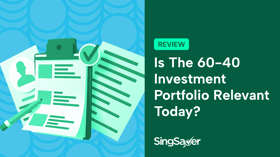Follow these six steps to make your investment portfolio so clean and tidy even Marie Kondo would approve.
Say you’ve been dabbling with investing, trying your hand at various methods. Perhaps you’re sitting on a robo-adviser account, two regular-savings plans, an insurance investment-linked plan (ILP) and are thinking of putting some money into bitcoin.
What to do with your CPF-OA balance that is just sitting there, inching upwards at 2.5% per annum?
Stop. Before you go any further (and make Marie Kondo cry), know that having a messy investment portfolio isn’t just inconvenient, it can actually affect your overall gains in future.
Instead, here’s what you should do to declutter that messy portfolio.
Why you should declutter your investment portfolio
Decluttering your portfolio will help you:
1. Achieve clarity in your investment holdings, letting you know if you’re on track
2. Weed out under-performing or worthless assets, and remove those that no longer align with your financial goals
3. Organise your holdings according to your financial needs
4. Prevent silly mistakes like panic-selling and FOMO-buying
How to declutter your investment portfolio
Here are the main steps to follow:
1. Evaluate your financial goals
2. Determine your investment budget
3. Categorise your various investments
4. Optimise your portfolio
5. Allocate your investment budget accordingly
6. Set a reminder in 12 months
Let’s go through them one by one.
1. Evaluate your financial goals
The very first thing you should do is to articulate your financial goals. What are the various outcomes you want from investing? Be as specific as possible. Some common goals could be to build a retirement nest egg, to save for a downpayment for a car, to build up a renovation fund, to set aside money for your little’s genius Yale tuition fees, etc. List them all down.
Next, categorise your financial goals according to a timeline. So using our example goals above:
- Downpayment for a car (in 2 years)
- House renovation (in 5 years)
- Yale education (in 15 years)
- Retirement (in 35 years)
Doing this will give you a schedule of financial targets to work towards, which will focus and guide your investment efforts.
2. Determine your investment budget
This simply means taking a look at your income versus your expenses so you have an idea of how much you can safely put into investments each month.
The key word is “safely”. You should never neglect your financial obligations, like debt, even to invest. Either clear your debt before you start investing, or at the very least, stabilise your debt by converting it to personal loans, such that you are no longer accruing interest.
Also, bear in mind that investments need time to do their magic and provide a return on your capital. Hence, it’s generally a bad idea to invest money that you need at short notice, as you’re likely to lose money due to fees and market movements.
In your investment budget, you may also include your savings (if you want to have better returns than your bank’s savings rate), bonuses, dividend payouts and even credit card cashback (in investing, every dollar counts!).
Once done with this step, you could end up with a mix of regular monthly sums and periodic lump-sums for your investment budget.
Categorise your various investments
Now that we’ve done the first two preparatory steps, we can begin the real work.
List down all the investments you have, and work out the annualised returns for each. It helps to be exact here, but even if all you can come up with is a rough gauge, that’s all right too.
Anything with an annualised return of less than 2.5% is a candidate for disposal.
Why? See, with the rate of inflation in Singapore spiking to 2.1% earlier this year, holding on to these investments won’t get you very far - you’re merely keeping pace with inflation, which means your money won’t be growing very much in real terms.
It is generally agreed that anything between 6% to 15% annualised returns is considered good for investors, so if you have investments that fall within (or exceed) that band, you may consider keeping them.
Optimise your portfolio
After evaluating your investments and getting rid of the non-performers, the next step is to optimise your portfolio. There are a few things to do here.
Merge similar investments
Let’s say you have two regular-savings plans and one robo-adviser account, and all three have similar annualised returns.
Choose one and merge your holdings from the other two into it and carry on investing into that account.
While it is logical to keep the one with the highest annualised returns, you should also check the fees charged by each. Going with the one with the lowest fees will give you the greatest benefit in the long run.
Same goes for your trading or brokerage accounts - just choose one with reasonable fees and close the others.
Separate insurance from investment
Insurance policies that combine protection with investment look good on paper, but their actual returns are often lacklustre.
This is because the premiums you pay are first used to cover the costs of insurance, with the remainder then being invested in the underlying fund. This means you aren’t investing as much money as you may think.
If you have an ILP which you are regularly paying, consider surrendering it when you hit the break-even point (that’s when the sum of premiums paid is equal to the cash value of the policy).
Then, purchase a term insurance plan for the protection you need (such plans are significantly cheaper, so you won’t need to spend as much in premiums), and add the money leftover into your investment budget.
That way, you increase the portion of your money that is working harder for you.
Align your portfolio with your financial goals
Now that you’ve tidied up your portfolio, it’s time to align it with your financial goals.
So going back to our example goals above, we can categorise them into:
| Short-term | Medium-term | Long-term |
| Downpayment for a car (ín 2 years) House renovation (in 5 years) |
Yale education (in 15 years) | Retirement (in 35 years) |
Therefore, from this, you know that you need some liquidity two and five years from now, and also some pretty large lump-sums in the medium- and long-term.
Armed with this knowledge, you can then align your investments accordingly. One strategy you could use for the above might look something like this:
- Short-term goals: Robo-adviser, conservative profile (ensures liquidity and stable returns at low risk)
- Medium-term goals: Endowment plan set to mature in 15 years (ensures disciplined investment)
- Long-term goals: Buy and hold index funds
You could take it one step further and do everything via a robo adviser, like so:
- Short-term goals: Start with a conservative profile
- Medium-term goals: Switch to a balanced profile once short-term goals have been met
- Long-term goals: Switch to an aggressive profile for the remainder of your investing years, then switch back to conservative profile at retirement for greater stability in your funds
Side note: If it seems like we’re favouring robo-advisers here, we’re not doing so intentionally.
It’s just that robo-advisers are set up to be convenient, user-friendly, and flexible enough to suit the needs of the average retail investor. Quite frankly, they are ideal for maintaining a neat and tidy investment portfolio.
Having said that, it’s perfectly fine to use whichever investment channels you’re most comfortable with.
Allocate your investment budget
The next thing to do is to put your plan in motion, by allocating your investment budget accordingly.
As a general rule, you should put more of your budget into short and medium-term goals, with the remaining going into your long-term goals.
Why so little into long-term goals like retirement, which is likely to be the most expensive of the bunch?
Well, because of compounding interest. With a long enough timeline, even a small amount can grow into a massive sum. This well-known principle of investing allows you to put more of your funds into meeting more immediate needs.
So perhaps you could allocate your budget like so:
| Short-term | Medium-term | Long-term |
| 50% | 35% | 15% |
Of course, you can choose whatever ratio that suits your needs the most, but don’t forget to adjust them as you go along.
Which brings us to our last step…
Set a reminder for 12 months out
Once you have decluttered and optimised your investment portfolio, leave it alone and let it do its thing. The only thing you have to do is to keep up with your investment payments.
It is a good idea to come back and check on your portfolio periodically - 12 months is a good interval - to see if you’re on track to meeting your financial goals.
You can also take the opportunity to make changes (if necessary, but avoid the temptation to meddle, because fees and market movements will rekt you), add new investments, take profit, adjust your budget, etc.
Decluttering your portfolio is key to investing success
Yes, decluttering your investment portfolio is no simple task. But once you get through it, you’ll be better placed to reap the returns that you are aiming for.
Lack of clarity is the number one reason why investors (and traders, especially) fail in the stock market. Without a clear plan and goals, it is easy to give in to our fears, causing us to panic-sell at a loss, or to dump money into unwise investments because “everyone’s doing it”.
This will cause you to lose your hard-earned money for entirely avoidable reasons - a fate absolutely nobody wants.
Read these next:
Investment Guide: SingSaver’s One-Stop Investment Shop
Guide To Property Investment In Singapore
5 Best Sustainable Investments In Singapore
5 Of The Best Things You Could Do With Your Investment Dividends
8 Investment Books to Read to Change Your Financial Life
Similar articles
Financial Topics That Are Safe for This Year’s Christmas/New Year Table
UOB 1-For-1 Buffet Promotions You Can Use with Your Credit Card
Catering or Home Cooking: Which is the Better Deal for Parties?
The Kris+ App is My Secret Travel Hack to Scoring Miles, Here's Why
5 Tips For Millennials To Start Adulting Financially
Best Instant Approval Credit Cards That Also offer Digital Cards
Alternative Solutions To Borrowing From Loan Sharks in Singapore
Top 8 Traditional Chinese Medicine (TCM) Clinics In Singapore










